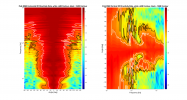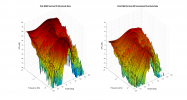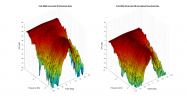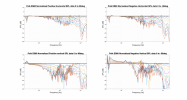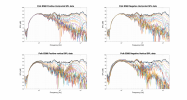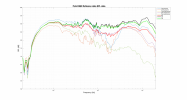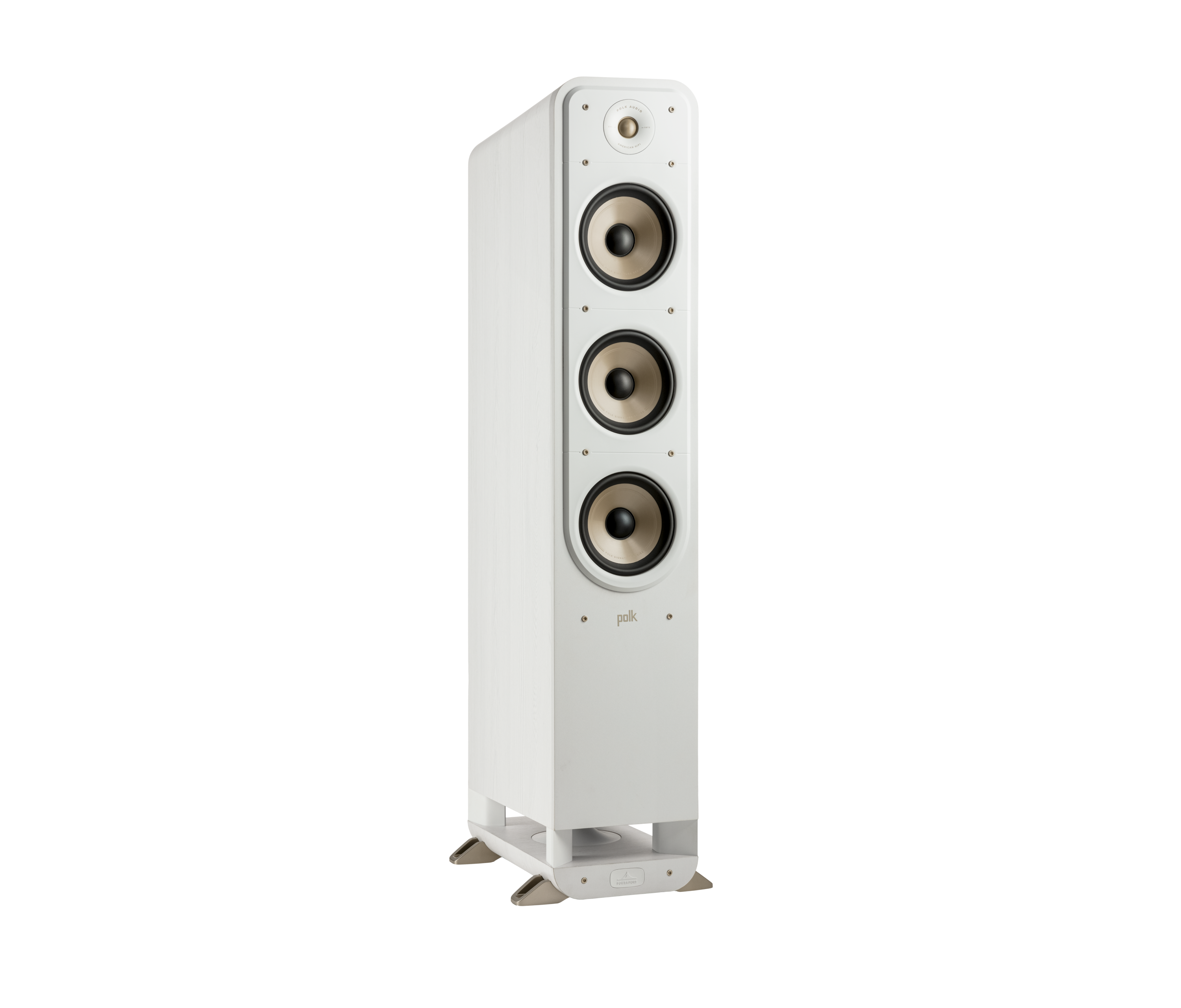This is a review, listening tests, equalization and detailed measurements of the Polk ES60 tower speaker. It was purchased new and kindly donated to the forum by a member. ES60 costs US $511 on Amazon and has 4.5 start average review (1925 ratings):

The ES60 is in entirely different class than other budget towers with good bit more weight and fit and finish. It uses the down firing port that Polk has in other speakers in the series.
I measured the ES60 on Klippel NFS without the grill with acoustic center of the tweeter. Temperatures in the measurement "chamber" was on the cool side at 57 degrees F/14 C.
Polk ES60 Speaker Measurements
As usual, we start with our suite of frequency response and directivity measurements:

I like the deep bass extension and high sensitivity. On minor side we have a resonant peak around 550 Hz and generally elevated treble response. The latter is shared with other Polk ES series using identical tweeter. Polk doesn't state the configuration of the speaker or even its crossover frequencies. My guess from near-field measurements is that it is a 2.5 way design with the top midwoofer allowed to go farther up in frequency range:

Would be nice if Polk ironed out the response of its tweeter some. Zooming into the port, we see some resonances that show up clearly in its distortion plot:

Distortion around 500 Hz has higher chance of audibility as it will travel up to where our hearing is most sensitive. Fortunately we will be applying EQ in this region and what is there is second harmonic so less reach as far as audible distortion.
I was surprised at the strong dip in early window response:

So do as I have and put a thick carpet on the floor between you and the speaker. That should reduce the energy of floor reflections in blue and help with that dip. As is, the predicted in-room response shows elevated treble response and lack of smoothness:

The peaking at 500 Hz may act as some compensation to counteract the brightness that treble response brings by boosting lower registers.
With three midwoofers handling bass, it is no surprise that distortion in that region is quite low:

In relative terms we see more midrange distortion due to lowering of the fundamental energy:

Pulling down the resonances in that region using a PEQ filter should help both fix the response and lower distortion.
As a test of robustness of this speaker, I swept it up to 105 dbSPL and it still hung in there with only slight amount of audible distortion increase during the sweeps:

Directivity is impressively good in horizontal axis:


I didn't expect that given the dip in early window response. Vertical response is quite uneven so best to point the tweeter to your ear:

Impedance is around 4 ohm and stays there for good bit of the frequency response:

Just noticed that it dips to 3.1 ohm above 5 kHz but fortunately there is not a lot of energy there.
Waterfall display shows the resonances we have talked about and some more around 3 to 6 kHz:

Finally, here is the step response for fans of that measurement:

Polk ES60 Listening Tests and Equalization
Three things immediately stood out on first listen:
1. Deep and clean bass, even more so than I expected! This thing plays with authority that no bookshelf/standmount speaker can ever dream to do. With bass level accounting for some 30% of our preference in speakers, this is a major plus.
2. Large image. This is another major advantage tower speakers have over bookshelves but once again, the impression was even more positive than I expected. Images are almost life-sized which I really appreciate (compared to miniatures with bookshelves).
3. Detailed and rather bright treble response. This has the usual effect of helping with imaging and giving the feeling of "resolution." This, I expected and while I appreciated its pluses, it was too much for my ears (but likely a design goal as part of sounding good in a "showroom").
I pulled out the EQ tool in Roon and it only took two filters to give me what I wanted:

Note that both are approximate/quick filters. With a couple more you could a more perfect job. As is, the 550 Hz got rid of some extra upper bass energy but then brightness stood out more. I put the quick and dirty shelving filter there which fixed that. In AB tests I could see someone may prefer the stock tuning better if they were not bothered by the extra brightness. To my ears though, I liked the more balanced response.
Once there, the ES60 aced all my reference tracks with deep bass extension that was essentially distortion-less. Combined with a large halo (despite me playing a single speaker), the overall experience was excellent. For grins, I pushed the speaker hard with my 400 watt/channel (8 ohm) amplifier and I got scared before the speaker did! It kept getting louder and sounding nicer and nicer.
Net, net, the subjective experience is more positive than cursory look at the measurements. It is easy to miss the bass extension there, or not consider the fact that this is a tall speaker so can portray a more realistic image. Or how clean it can play even down to lower notes.
Conclusions
For probably $200 more, the ES60 easily separates itself from rest of the competition in budget tower speaker category. It feels substantial and delivers on that in considerable amount of bass response and high sensitivity (which translates into more usable SPL with less amplification). You could convince yourself that it is not as good as it is by focusing on its flaws in objective measurements, missing some positives that were quite evident in listening tests.
If this is a 2.5 way design, I am even more impressed as these are so hard to get right when all the drivers and ports contribute to mid frequencies, usually creating a mess. This is avoided for the most part.
I am going to put the Polk ES60 on my recommended list if you can tame its brightness with some filtering. Personally, I like it more than I should!
------------
As always, questions, comments, recommendations, etc. are welcome.
Any donations are much appreciated using: https://www.audiosciencereview.com/forum/index.php?threads/how-to-support-audio-science-review.8150/
The ES60 is in entirely different class than other budget towers with good bit more weight and fit and finish. It uses the down firing port that Polk has in other speakers in the series.
I measured the ES60 on Klippel NFS without the grill with acoustic center of the tweeter. Temperatures in the measurement "chamber" was on the cool side at 57 degrees F/14 C.
Polk ES60 Speaker Measurements
As usual, we start with our suite of frequency response and directivity measurements:
I like the deep bass extension and high sensitivity. On minor side we have a resonant peak around 550 Hz and generally elevated treble response. The latter is shared with other Polk ES series using identical tweeter. Polk doesn't state the configuration of the speaker or even its crossover frequencies. My guess from near-field measurements is that it is a 2.5 way design with the top midwoofer allowed to go farther up in frequency range:
Would be nice if Polk ironed out the response of its tweeter some. Zooming into the port, we see some resonances that show up clearly in its distortion plot:
Distortion around 500 Hz has higher chance of audibility as it will travel up to where our hearing is most sensitive. Fortunately we will be applying EQ in this region and what is there is second harmonic so less reach as far as audible distortion.
I was surprised at the strong dip in early window response:
So do as I have and put a thick carpet on the floor between you and the speaker. That should reduce the energy of floor reflections in blue and help with that dip. As is, the predicted in-room response shows elevated treble response and lack of smoothness:
The peaking at 500 Hz may act as some compensation to counteract the brightness that treble response brings by boosting lower registers.
With three midwoofers handling bass, it is no surprise that distortion in that region is quite low:
In relative terms we see more midrange distortion due to lowering of the fundamental energy:
Pulling down the resonances in that region using a PEQ filter should help both fix the response and lower distortion.
As a test of robustness of this speaker, I swept it up to 105 dbSPL and it still hung in there with only slight amount of audible distortion increase during the sweeps:
Directivity is impressively good in horizontal axis:
I didn't expect that given the dip in early window response. Vertical response is quite uneven so best to point the tweeter to your ear:
Impedance is around 4 ohm and stays there for good bit of the frequency response:
Just noticed that it dips to 3.1 ohm above 5 kHz but fortunately there is not a lot of energy there.
Waterfall display shows the resonances we have talked about and some more around 3 to 6 kHz:
Finally, here is the step response for fans of that measurement:
Polk ES60 Listening Tests and Equalization
Three things immediately stood out on first listen:
1. Deep and clean bass, even more so than I expected! This thing plays with authority that no bookshelf/standmount speaker can ever dream to do. With bass level accounting for some 30% of our preference in speakers, this is a major plus.
2. Large image. This is another major advantage tower speakers have over bookshelves but once again, the impression was even more positive than I expected. Images are almost life-sized which I really appreciate (compared to miniatures with bookshelves).
3. Detailed and rather bright treble response. This has the usual effect of helping with imaging and giving the feeling of "resolution." This, I expected and while I appreciated its pluses, it was too much for my ears (but likely a design goal as part of sounding good in a "showroom").
I pulled out the EQ tool in Roon and it only took two filters to give me what I wanted:
Note that both are approximate/quick filters. With a couple more you could a more perfect job. As is, the 550 Hz got rid of some extra upper bass energy but then brightness stood out more. I put the quick and dirty shelving filter there which fixed that. In AB tests I could see someone may prefer the stock tuning better if they were not bothered by the extra brightness. To my ears though, I liked the more balanced response.
Once there, the ES60 aced all my reference tracks with deep bass extension that was essentially distortion-less. Combined with a large halo (despite me playing a single speaker), the overall experience was excellent. For grins, I pushed the speaker hard with my 400 watt/channel (8 ohm) amplifier and I got scared before the speaker did! It kept getting louder and sounding nicer and nicer.
Net, net, the subjective experience is more positive than cursory look at the measurements. It is easy to miss the bass extension there, or not consider the fact that this is a tall speaker so can portray a more realistic image. Or how clean it can play even down to lower notes.
Conclusions
For probably $200 more, the ES60 easily separates itself from rest of the competition in budget tower speaker category. It feels substantial and delivers on that in considerable amount of bass response and high sensitivity (which translates into more usable SPL with less amplification). You could convince yourself that it is not as good as it is by focusing on its flaws in objective measurements, missing some positives that were quite evident in listening tests.
If this is a 2.5 way design, I am even more impressed as these are so hard to get right when all the drivers and ports contribute to mid frequencies, usually creating a mess. This is avoided for the most part.
I am going to put the Polk ES60 on my recommended list if you can tame its brightness with some filtering. Personally, I like it more than I should!
------------
As always, questions, comments, recommendations, etc. are welcome.
Any donations are much appreciated using: https://www.audiosciencereview.com/forum/index.php?threads/how-to-support-audio-science-review.8150/
